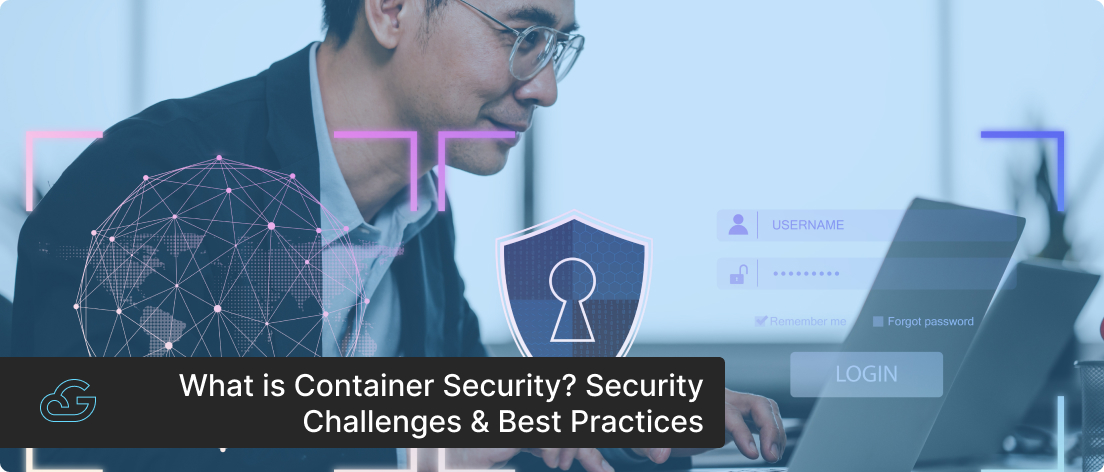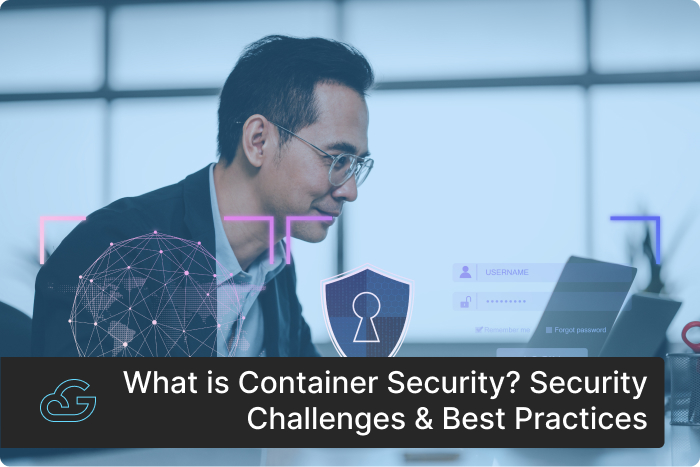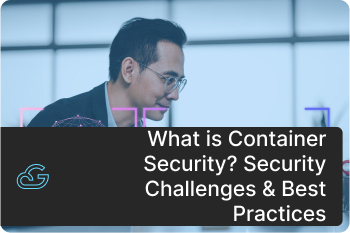Blogs / Containers
What is Container Security? Security Challenges & Best Practices
By
Sherin Job Varghese
Posted: February 07, 2024
• 7 min read
Over the past few years, there's been a noticeable surge in organizations adopting container technology for their application development. Major companies such as Netflix, Amazon, Uber, and Spotify are fully on board with containerized microservices, aiming to achieve quicker development and deployment of applications.
However, alongside this adoption, many organizations encountered setbacks, experiencing delays or slowdowns in deploying applications due to security challenges. Consequently, the emphasis on container security has heightened in recent years as a critical focal point for organizations.
This blog explains key components and best practices that form the grounds of effective container security. It provides insights into how organizations can strengthen their containerized environments against cyber threats.
What is Container Security?
Container security refers to the set of practices, tools, and strategies employed to protect containerized applications throughout their entire lifecycle. It aims to mitigate risks associated with vulnerabilities, misconfigurations, and malicious activities that could compromise the confidentiality, integrity, and availability of containerized applications.
Executing container security involves the following approaches:
-
Protect the containerized application and its development pipeline.
-
Strengthen the infrastructure and deployment environments supporting containerized workloads.
-
Implement security measures to safeguard containerized workloads during runtime.
Importance of Container Security in Application Development
The significance of container security is not confined to a specific phase but spans the entire Software Development Lifecycle (SDLC), from initial development to deployment and runtime.
-
Development Phase
-
Deployment Phase
-
Runtime Phase
Container security begins in the development phase by addressing vulnerabilities introduced through insecure container images or misconfigurations. Early threat mitigation ensures applications are built with integrity, minimizing the risk of later lifecycle threats.
Container security is essential to safeguard deployment environments against threats associated with insecure orchestration settings and inadequate network controls. This resilience ensures that applications remain secure and perform optimally, regardless of the deployment environment.
At the runtime phase, container security provides visibility and monitoring capabilities. This is fundamental for real-time detection and response to security incidents. A lack of visibility during runtime can lead to delayed identification of breaches.
Common Causes of Security Incidents in Containerization
The main factors that contribute to the security risks in containerization are the following:
-
Vulnerable Images: Outdated or unpatched images that may contain known vulnerabilities that attackers can exploit.
-
Misconfigurations: Improper configuration settings can create openings for unauthorized access or unintended behaviors, compromising security.
-
Insecure Dependencies: The use of insecure third-party components can introduce vulnerabilities into the containerized application.
-
Lack of Isolation: Insufficient isolation between containers allows security breaches to spread and compromise the overall environment.
-
Orchestration Flaws: Security vulnerabilities within orchestration platforms create potential points of exploitation for malicious actors, resulting in orchestration flaws.
-
Inadequate Access Controls: Weak access controls may lead to unauthorized users gaining control over containers and associated resources.
-
Unencrypted Communication: Lack of encryption in communication exposes data to potential interception, posing a threat to confidentiality.
-
Insufficient Logging and Monitoring: Without proper monitoring, security incidents may go undetected, delaying response and mitigation efforts.
-
Registry Risks: Insecure registries can compromise the integrity of container images or expose sensitive information.
-
Limited Visibility: Security teams may struggle to identify and respond promptly to suspicious activities or breaches without adequate visibility.
Key Components of Container Security
Understanding the components of container security and implementing security at each component level is an essential step in creating a resilient and secure containerized environment. The following are the common components of container security that are fundamental in safeguarding applications and data throughout the container lifecycle.
-
Registry Security
-
Runtime Security
-
Environment Security
-
Orchestration Security
-
Storage Security
-
Network Security
Registry security involves safeguarding the repositories where container images are stored; breaches in these repositories can lead to the infiltration of malicious code into images, consequently propagating malware throughout containerized environments. To prevent unauthorized access, implementing strict access controls on container registries is important. Additionally, monitoring registries for unusual access patterns can help detect potential malicious activity.
Runtime security involves keeping container runtimes safe from vulnerabilities. Attackers may exploit these vulnerabilities to take control of containers, posing a risk to host servers. To mitigate this risk, ensure that container runtimes are regularly patched and updated. Stay vigilant, particularly regarding the security of the Docker container runtime or the specific runtime in use.
Environment security focuses on the security implications of the configuration applied while running containers. This is especially crucial when containers are executed with root privileges, as it introduces heightened security risks. To mitigate potential harm from breaches, adhere to security best practices for containerized environments.
Orchestration security involves ensuring the secure operation of containerized workloads that utilize orchestrators such as Kubernetes. This necessitates a robust orchestration platform that is free from vulnerabilities. To achieve this, follow best practices in orchestrator configuration and management. Utilize built-in frameworks like Role-Based Access Control (RBAC) to effectively restrict access to resources within orchestrators.
Storage security applies to safeguarding stateful containerized applications that depend on storage resources, underscoring the critical need to protect the data hosted within them. To ensure robust security, implement measures to secure and protect data within storage resources. Consider employing encryption and access controls for an additional layer of heightened security.
Network security for containers involves ensuring the proper configuration and monitoring of networks, as containers depend on them for both internal communication and external requests. To enhance containerized network security, secure both internal and external networks. Regularly monitor network activity for any unusual patterns that may indicate potential security threats.
What are the Challenges Associated with Container Security?
Even though containers streamline application delivery with advantages like cross-platform portability and isolated execution, their dependence on the host OS for hardware access and the use of multiple underlying images within a single container introduce unique security challenges. Some of them are explained below:
-
Complexity in Maintaining a Consistent Container Environment
-
Complex Vulnerability Management Process
-
Inadequacy of Specialized Container Monitoring Solutions
-
Risk of Supply Chain Attacks
Unlike traditional infrastructure, containers are rapidly initiated and terminated in response to demand, leading to challenges in maintaining a consistent and secure environment. This dynamic behavior requires organizations to adapt their security measures to effectively address the constantly changing container environment.
Containerized environments often leverage images with multiple layers, each potentially introducing vulnerabilities. Managing these vulnerabilities throughout the container lifecycle becomes a critical task, demanding constant vigilance and proactive measures.
The challenge lies in monitoring the transient nature of containers using traditional tools. To track anomalies and respond promptly to security incidents, visibility into container workloads is important. Specialized container monitoring solutions are imperative for teams to enable real-time threat detection, analysis, and mitigation for a proactive security approach.
Containers often rely on a chain of images and components from diverse sources and face the risk of supply chain attacks. Any compromise in this chain can have severe consequences. To safeguard against such threats, organizations must implement strict controls and validation mechanisms, minimizing the risk of malicious components infiltrating containerized environments.
Best Practices to Ensure Container Security
The above challenges collectively highlight the need for a holistic and adaptive approach to container security. Organizations must leverage container-specific security tools, adhere to best practices, and continuously educate their teams on the evolving threat scenarios. Let’s find out some container security best practices that organizations can implement to ensure the security of their container environments.
-
Include Code Scanning in the CI/CD Process
-
Integrate code scanning into the CI/CD process to prevent flaws and malicious content from creeping into the system.
-
Utilize tools like Sonarqube, a Static Application Security Testing (SAST) tool, to scan all code languages for vulnerabilities, thereby enhancing code quality.
-
Ensure the Security of Container Runtime
-
Secure Container Runtime by implementing practices like using separate VPNs for Containers to enhance isolation and limit connectivity between containers.
-
Expose only necessary ports, preferably only the SSH port, and ensure encrypted communication between containers using TLS to bolster container security.
-
Integrate Image Scanning
-
Inspect container images carefully, especially those from third parties, by integrating image scanning into the CI/CD pipeline to identify and eliminate vulnerabilities before deployment.
-
Regularly update container images and make image scanning tools like Aquasec as an integral part of the DevSecOps workflow to ensure the publication of secure container images.
-
Reduce the Attack Surface:
-
Minimize potential attack vectors by eliminating unnecessary software, services, and open network ports within the container environment.
-
Trim down components and services, reducing opportunities for hackers and enhancing security by limiting potential points of vulnerability.
-
Prepare an Incident Response Plan
-
Develop a well-defined incident response plan specifically for container-related security issues to minimize damage and downtime.
-
Outline procedures for identifying and recovering from security incidents involving containers, including scenarios such as container breakout, image vulnerabilities, and misconfigurations.
-
Implementing Regular Audits
-
Conduct regular audits of container activities, configurations, and components to detect irregularities or deviations from standard operations.
-
Monitor and analyze audit logs regularly to identify trends and detect anomalies.
-
Enforcing the Least Privilege Principle
-
Adhere to the principle of least privilege by limiting container permissions, utilizing read-only file systems, and controlling access to system resources.
Understand the Shared Responsibility in Container Security
In container security, a shared responsibility model dictates a collaborative approach between cloud service providers and users. Cloud providers manage the security "of" the cloud, encompassing infrastructure and orchestration services, such as Amazon ECS/EKS, Azure AKS, or Google Kubernetes Engine. Meanwhile, users are tasked with ensuring security "in" the cloud, focusing on protecting their containerized applications. This model highlights that while cloud providers provide tools for securing the infrastructure and orchestration layer, users must actively implement measures to safeguard their containers and the applications they run.
Ensure Container Security with Gsoft Cloud’s Managed Container Solutions
Gsoft Cloud's Managed container services are designed to simplify the deployment, orchestration, and scaling of your applications. Our comprehensive container management solutions ensure easy maintenance, updates, and optimization of your containerized environments.
Key Features:
-
Rapid deployment of applications across multiple environments with a few clicks and reduced time-to-market.
-
Utilize advanced orchestration tools for efficient resource utilization.
-
Ensure high availability and fault tolerance with automated application scaling.
-
Implement integrated monitoring and logging to track containerized applications' performance.
-
Adopt robust security measures to safeguard your containerized workloads.
-
Implement granular access controls and encryption to ensure container security.
-
24/7 support and management to ensure continuous monitoring and management of containerized environments.
Address the intricacies of container security with Gsoft Cloud’s managed container services. Contact us today to get tailored insights on securing your containerized applications and face the evolving threats with confidence.


Get Know More About Our Services and Products
Reach to us if you have any queries on any of our products or Services.











